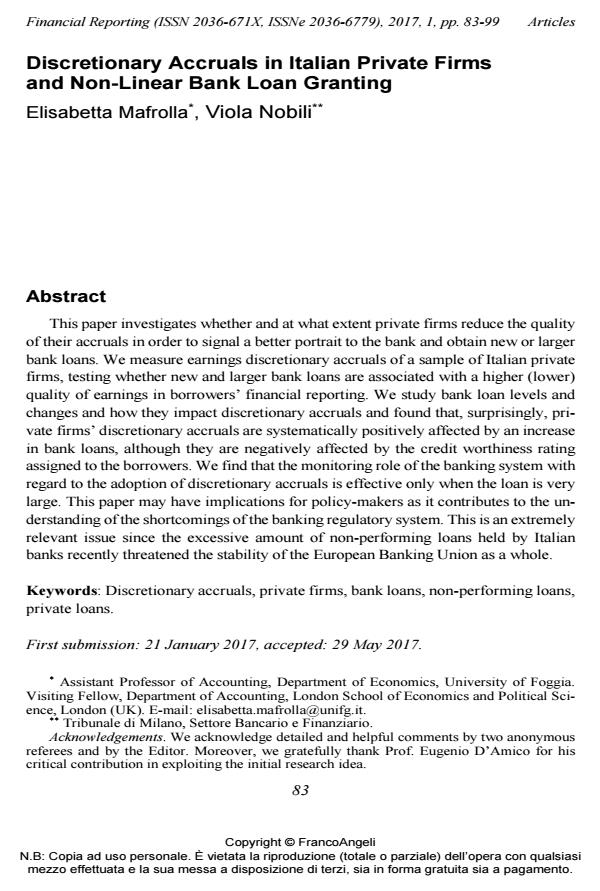Discretionary Accruals in Italian Private Firms and Non-Linear Bank Loan Granting
Titolo Rivista FINANCIAL REPORTING
Autori/Curatori Elisabetta Mafrolla, Viola Nobili
Anno di pubblicazione 2017 Fascicolo 2017/1
Lingua Inglese Numero pagine 17 P. 83-99 Dimensione file 241 KB
DOI 10.3280/FR2017-001004
Il DOI è il codice a barre della proprietà intellettuale: per saperne di più
clicca qui
Qui sotto puoi vedere in anteprima la prima pagina di questo articolo.
Se questo articolo ti interessa, lo puoi acquistare (e scaricare in formato pdf) seguendo le facili indicazioni per acquistare il download credit. Acquista Download Credits per scaricare questo Articolo in formato PDF

FrancoAngeli è membro della Publishers International Linking Association, Inc (PILA)associazione indipendente e non profit per facilitare (attraverso i servizi tecnologici implementati da CrossRef.org) l’accesso degli studiosi ai contenuti digitali nelle pubblicazioni professionali e scientifiche
This paper investigates whether and at what extent private firms reduce the quality of their accruals in order to signal a better portrait to the bank and obtain new or larger bank loans. We measure earnings discretionary accruals of a sample of Italian private firms, testing whether new and larger bank loans are associated with a higher (lower) quality of earnings in borrowers’ financial reporting. We study bank loan levels and changes and how they impact discretionary accruals and found that, surprisingly, private firms’ discretionary accruals are systematically positively affected by an increase in bank loans, although they are negatively affected by the credit worthiness rating assigned to the borrowers. We find that the monitoring role of the banking system with regard to the adoption of discretionary accruals is effective only when the loan is very large. This paper may have implications for policy-makers as it contributes to the understanding of the shortcomings of the banking regulatory system. This is an extremely relevant issue since the excessive amount of non-performing loans held by Italian banks recently threatened the stability of the European Banking Union as a whole.
Parole chiave:Discretionary accruals, private firms, bank loans, non-performing loans, private loans.
- The Italian depreciation suspension policy during the COVID-19 pandemic: consequences on private firms’ borrowing capacity Marco Maria Mattei, Matteo Merlo, Eleonora Monaco, in Accounting in Europe /2023 pp.166
DOI: 10.1080/17449480.2023.2174444 - Accrual quality, investor reaction to earnings, and the confirmatory role of sales news Carlo D�Augusta, in FINANCIAL REPORTING 2/2023 pp.97
DOI: 10.3280/FR2023-002004
Elisabetta Mafrolla, Viola Nobili, Discretionary Accruals in Italian Private Firms and Non-Linear Bank Loan Granting in "FINANCIAL REPORTING" 1/2017, pp 83-99, DOI: 10.3280/FR2017-001004